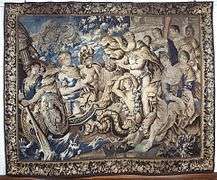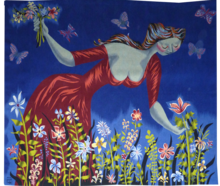Aubusson tapestry
The Aubusson tapestry manufacture of the 17th and 18th centuries managed to compete with the royal manufacture of Gobelins tapestry and the privileged position of Beauvais tapestry.[1] Tapestry manufacture at Aubusson, in the upper valley of the Creuse in central France, may have developed from looms in isolated family workshops established by Flemings that are noted in documents from the 16th century.

Typically, Aubusson tapestries depended on engravings as a design source or the full-scale cartoons from which the low-warp tapestry-weavers worked. As with Flemish and Parisian tapestries of the same time, figures were set against a conventional background of verdure, stylized foliage and vignettes of plants on which birds perch and from which issue glimpses of towers and towns.
The town of Felletin is identified as the source from which came the Aubusson tapestries in the inventory of Charlotte of Albret, Duchess of Valentinois and widow of Cesare Borgia (1514).[2]
- Aubusson tapestry after Jean-Baptiste Huet, c. 1786
 Aubusson tapestry from Arles
Aubusson tapestry from Arles Aubusson tapestry; design by Isaac Moillon
Aubusson tapestry; design by Isaac Moillon

- Le Bouquet (1951) by Marc Saint-Saens is among the best and most representative French tapestries of the fifties. It is a tribute to Saint-Saens’s predilection for scenes from nature and rustic life. [3]
Notes
- R. A. Weigert, French Tapestry 1956: 135–142.
- Weigert 1956:136.
- HENG, Michèle (1989), Marc Saint-Saens décorateur mural et peintre cartonnier de tapisserie, 1964 pages.
External links
